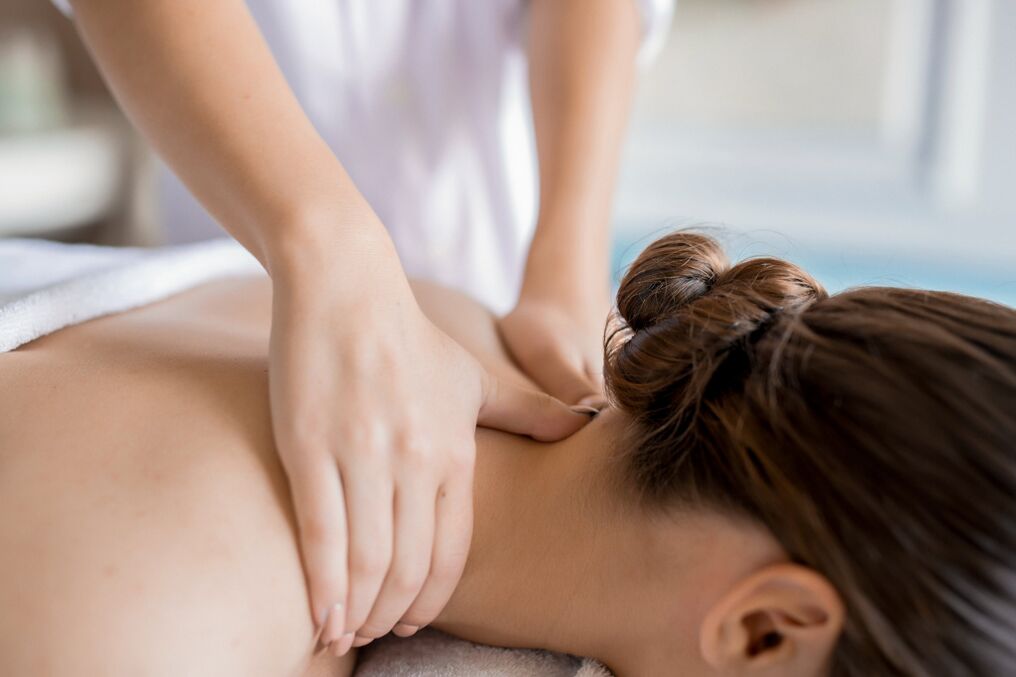In the human neck there is a huge number of nerve packages and blood vessels that ensure the normal functioning of the brain and sensory authorities.The most common oven cause is cervical osteochondrosis - a dangerous degenerative disease of cartilage and bone tissue, accompanied by heavy pain, deterioration of hearing, vision and cognitive functions, in the form of stiffening in the face and gradual loss of work capacity.
If you feel pain and stiffness when turning your head, frequent dizziness or weakness in your arms, time to consider treatment for cervically osteochondrose.

Cervical osteochondrose causes
Cervical osteohondrose has its own characteristics due to its anatomical structure.The spine of the cervical spine are smaller than lumbar, and even thoracic, and also perceive a constant static load (weight of the head).During the day, loads can be expressed in maintaining the same posture - for example, when reading the documents, working on the computer.The neck often is often deprived of rest due to a non-physiological position for sleeping and an unpleasant pillow (head or "hanging" on a pillow or is support pressure and support pressure).As a result of this pretense state, the so-called muscle search muscle.Certain muscle groups experience excessive stress and therefore need a longer period of rest and recovery, but they do not receive them - after all, no one has canceled the schedule.
All this causes permanent tension in some muscle groups and dystrophin changes, and often leads to the appearance of the "turtle door" (personal proposition, while the head protrudes forward, and the neck forwards, and the neck is a characteristic deviation).In such a situation, the weight of the head falls on Atlas, the first cervical vertebra.It is forced to take that part of the cargo that handle the neck of the door during normal physical development.But the fact is that it is not suitable for such a task at all!
Additional factors that can accelerate the wear of intervertebral cartilage in the hrline spine often include:
- Age change and hormonal changes - most often after 45 years (inorganic substances overcome its organic ones, which reduces bone flexibility and causes their mineralization, and bone tissue destruction occurs faster than growth);
- Door injuries and other parts of the spine;
- cardiovascular diseases;
- Congenital anomalies of muscle-bone system and acquired postural disorders;
- Physical inactivity (after all, the intervertebral joints doors are the most unfortunate, and various loads are required for their health);
- Smoking and other bad habits.
Stages of cervical osteochondrose
The cervical osteochondorosis stage was established on the basis of diagnostic criteria.These include patient sensations, palpation, door mobility assessment, as well as the clearance of the common space between vertebral and other indicators on X-ray.Depending on the disease phase, an orthopedic doctor selects treatment for osteochondrose, preventive measures and, if necessary, support orthoses.
1. degree of cervical osteochondrose
1 Cervical osteochondrosis of Grlić Rocket is also called the preclinical phase.Patients, as a rule, ignore the first symptoms of cervical osteochondrose and treatment are not carried out because of their mild severity.They are attributed to fatigue after the workday, the unpleasant position of sleep, stress, migraines and various diseases.Patients feel:
- stiffness in the neck, especially in the morning or after a long stay in the same position;
- pain when sharply turning their head;
- Frequent headaches (including when the weather changes).
At this stage of the disease, the treatment of cervical osteochondrose in women is most likely - because their symptoms are more pronounced.This is due to the specificity of work and physical activity (for example, working in the office during the day and bending through the sink or child's homework in the evening), as well as hormonal and anatomical characteristics (mineral density of minerals and mineral muscle density).In the proprietary phase, women are especially characterized by pressure surge, stiffness and dlebonyness of the skin (especially on the face), the tendency of unconscious and dizziness, nausea and some other symptoms of cerebral hypoxia.
The symptoms and treatment of cervical osteochondrosis arise in patients aged 45 to 65, but with chronic fatigue, excessive physical activity and other risk factors can occur completely early - for 25 years.
At this stage, the disease can be fully defeated with the help of therapeutic exercises, fats for cervical osteochondrosis, training in orthopedic regime and normalization of diet.
2. Degree of cervical osteochondrosis
In the second phase of the disease, the height of the intervertebral cartilage, which plays the role of shock absorbing lining between vertebral, starts to reduce.Therefore, microtraw to the door often occurs during sharp turns, jumps or excessive loads.The protrusion (bulge) of intervertebral disks and radio syndrome appears.
These changes cause strong pain - both in the head and neck.The ability to concentrate, thinking speed and sensitivity to reduce facial and hands.Patients complain about increased fatigue and irritability.At this stage, efficient drug drugs are already needed on cervical osteochondrose.
3. Degree of cervical osteochondorosis
Heavy and acute pain is constant and can radiate to hand, upper back or back of the head.One or both patients quickly become tired.The process begins to spread to adjacent compounds due to the disorder of natural spinal compensation functions.The patient has difficulty or cannot turn his head at all due to the formation of bone growth - osteophytes, as well as the fact that the cartilage is replaced by the connective tissue.Each movement, if possible, is accompanied by a rough crisis.The neck loses mobility, muscle atrophy.Hernias are often formed and cracks appear on the vertebrae.There is noise in the ears.
Cervical osteochondrose treatment
Cervical osteochondrosis treatment is performed comprehensively, taking into account the age, construction, profession, the level of physical ability of the patient, his lifestyle and presence of concurrent diseases.Therefore, the suitability of specific therapeutic measures in the treatment of cervical osteochondries in women and men should determine the doctor attending.

Physiotherapy for cervical osteochondrosis
To mitigate pain, alleviate inflammation, improve the introduction of nerves and nurture your brain, the following physiotherapy methods for cervical osteochondrose treatment are used:
- Ultrasound therapy and phonopholes - have a heating effect, improve the effect of external drugs;
- Electrophoresis - improves the effect of giving drugs, has a stimulating and heating effect;
- Shock therapy (SWT) - activates blood supply, mitigates inflammation and improves bone and cartilage regeneration processes;
- Electroostimulation - improves the mobility and durability of the neck and hand, relieves pain;
- Cold and ozone therapy - reduce pain and inflammation, help reduce dosing of corticosteroid drugs;
- Physical therapy and kinesitherapy - strengthens neck muscles, improves blood circulation and metabolism, maintains the mobility of the door;
- Hand therapy and mechanical traction (tow) - helps to solve tension and pain;
- Acupuncture - helps maintain mobility and nerve sensitivity;
- Paraffin applications - stimulate metabolic processes, reduce pain.
Sanatorium methods for cervical osteochondrose treatment are efficient and favorable - for example, balneotherapy (water sulfide, radon and turpentine baths), hyrudotherapy (cure leeches).
Massage in the treatment of osteochondorosis doors
Therapeutic, lymphatic drainage massage and physiotherapy have a positive effect on intervebrebral discs, bone tissue, muscles and ligaments of cervar spine.Some movements can be done independently - for example, rubbing cervix, parotid space and shoulders, mix the neck with their fingers and edge of the palm, tapping, hitting and movement at the back door.In the treatment of osteochondrose cervical vertebrae, it would be useful to have a circular massage of the back of the head, as well as heating for a key area, shoulders and upper back.Massage before exercising exercise exercises are especially effective.You can combine it with the application of fat for cervical osteochondrose treatment.
Hydromassage - physiotherapy technique that improves metabolism, inhibits fibrous growth, is recommended for osteochondrose technique, inhibits fibrous growth, helps headaches and improvement of nervous implementation.
Exercise therapy for cervical osteochondrosis
The lack of appropriate physical activity on neck and back muscles is the main reason for the development and further advancement of cervical osteochondrosis.Therefore, daily exercises are used to prevent this disease prevention and treatment (but not for the treatment of worsening cervical osteochondrose!).Note that exercises must be performed at least 3-5 times a day (1 time in the morning after waking up).All movements should be smooth, without jerks.If you feel pain while performing exercise, stop it, and if the performance of the entire complex is painful for you, contact an orthopedist for cervical osteochondrosis and visiting physico therapy.
You can perform the following exercises every day (5-7 reps):
- Press the palm on the forehead and strain the neck, trying to move the palm forehead.Repeat this exercise for the back of your head, then, in turn, for right and left temple.
- Tilt your head back, then slowly lower it, press your chin to your chest.
- Get straight up straight and turn your head more departier to the left.Repeat the exercise on the right.
- Tilt your head back and try touching your ear in your shoulder.Repeat on both sides.
- Lower your chin to the southern reap and first turn your head in one direction (5 times or more), similar to the other.
The shoulder for heating, such as "mill", will also be convenient.Everyday exercises in the early stages of the disease help without tablets to treat cervical osteochondrose.
Note: If you have already diagnosed with osteochondrose, you should not describe your head in full circle, as this can be traumatic.
Drugs and preparations for cervical osteochondorosis treatment
Starting from 2. Phases of the disease, medications are used to treat the worsening of cervical osteochondrosis.But it will not be possible under control only with the help of pharmacotherapy - it is therefore important to combine drugs and drugs listed below to treat cervical osteochondrose with therapeutic exercises, physiotherapy and wearing orthosis).
Chordroprotectors for cervical osteochondrosis
ChondraTrovers activate the processes of cartilage and bone tissue regeneration, and thus are excellent as supporting treatment for osteochondrosis doors.Taken 3 to 6 months.They are also produced in the form of tablets for the treatment of osteochondrose cervix, and in the form of bags, injections and capsules.
For the consolidation of the remission and the treatment of osteochondrosis of cervix, doctors recommend hondroprotective drugs.
Countercupal medicines for cervical osteochondrosis
Anti-inflammatory remedies for cervical osteochondorosis are divided into non-steroid (NSAID) and steroid (hormonal) drugs.Both groups are taken in short courses as prescribed by the doctor - in the form of tablets for the treatment of cervical osteochondrosis or intramuscular injections.Steroids are used in later stages of diseases, when pain cannot be overcome differently.
Antispasmodics and angiprovers
When treating cervical osteochondrosis, it is important to protect the central nervous system that is at risk with this disease.Therefore for an efficient drug drug osteochondrosis, doctors recommend taking:
- Antispasmodics.
- Angiprovers.
- Notropics, amino acids and vitamin brain complexes.
Outer heating
Heating gels, creams and fats for cervical osteochondrosis improves blood flow, mitigate inflammation and distract patients from pain.
Diet in the treatment of cervical osteochondrose
Osteochondrosis of cervix can be classified as the so-called"Diseases of the whole body."Therefore, in the treatment of cervical osteochondrosis, the diet has two goals: the body saturation of nutrients and restrictive substances that contribute to dehydration, joint mineralization and destruction.
Therefore, when treating cervical osteochondrosis, a special place should be given in a diet:
- Poultry, skinny beef, game, liver and offal.
- Seafood - fish, shellfish, crabs, edible algae.
- Eggs and dairy products.
- Full cereals and legumes - oats, wheat (including germinated wheat), brown rice, beans, peas.
- Vegetables - carrots, spinach, bell peppers, broccoli, lettuce and others.
- Fruits - Apricots, bananas, citrus, plums, apples, avocado, peaches, pomegranate.
- Walnuts.
- Any berries (fresh, dried, frozen) and dried fruit.
But it is better to exclude marinades, salty dishes, fast food, semi-finished products and sausages completely.It is also important to reduce white bread, potatoes, sweets and dried fruits), carbonated drinks and coffee "in the menu - it will reduce the need to treat medication for osteochondrose thunderstorm.

























